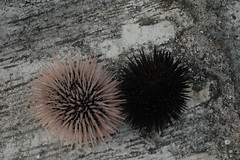 Sea Urchins (Photo credit: airforcefe)
Sea Urchins (Photo credit: airforcefe)
Because its preferred source of nutrition is algae, it does have a place in a well-balanced ecosystem. However, left unchecked by predators, sea urchins can have a devastating effect on an ecosystem by obliterating macroalgae and the species that also depend on this food source to survive. Scientists call this phenomenon an “urchin barren”. Since they prefer to live in relatively shallow coastal waters, the presence of crabs, sea otters, eels, large starfish, and sea birds can help keep populations from exploding. Sea urchins are also quite popular among sushi enthusiasts, where the “roe” is collected for consumption.
Although they may seem to be rooted in one spot, sea urchins are anything but sessile. They move around by way of hundreds of tiny tube feet, just like a starfish or a sand dollar. Since their mouth is located on the underside, they spend much of their time foraging along the ocean floor, consuming algae, decaying organic matter, and other little bits of food. You may see urchins on the sea floor in colonies at times, and there is a very important reason for this. When sea urchins spawn, it takes place externally, in the water column. The male will first release its sperm, followed by a release of eggs by the female, and fertilization occurs when the eggs and sperm make contact. The more males and females there are in one consolidated area, the better chance there is to produce more embryos.
The origins of the sea urchin date back to about 450 million years ago, and have ever since been adapting to changing environments and conditions over eons to maintain their place in evolutionary history. For a creature that has no true brain, we have to take our hats off to the amazing capability for survival that the lowly sea urchin displays.
Thanks to AquaViews
Kathy Dowsett
www.kirkscubagear.com

No comments:
Post a Comment